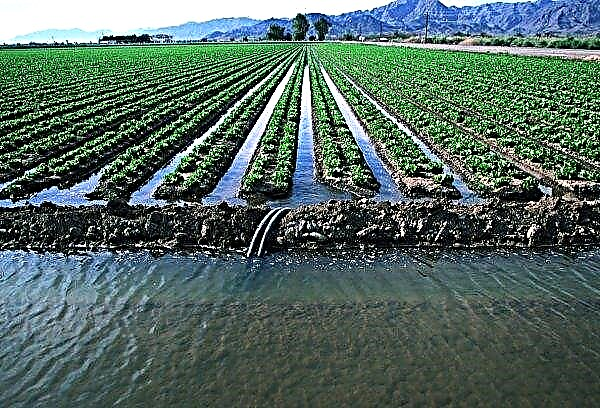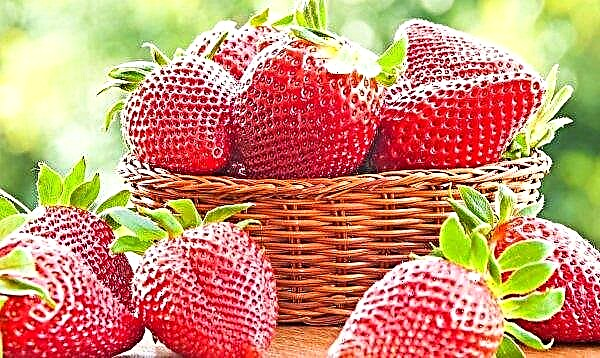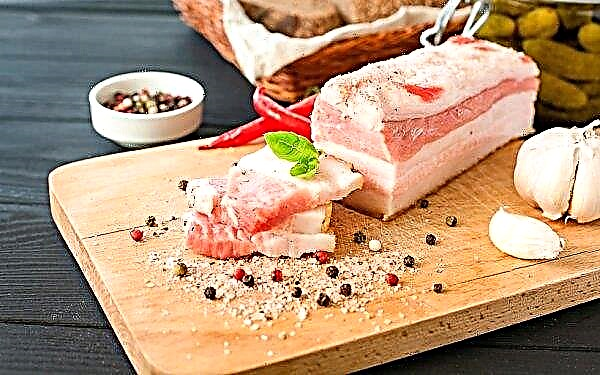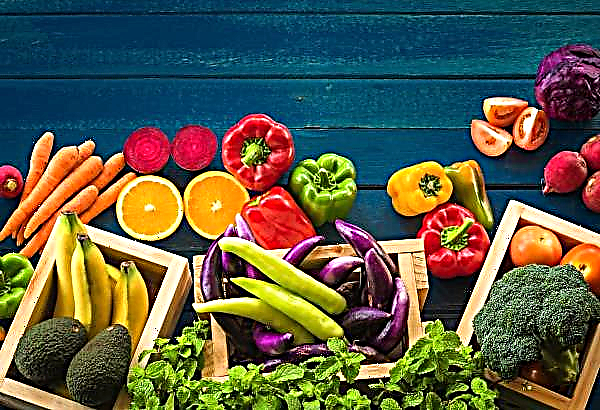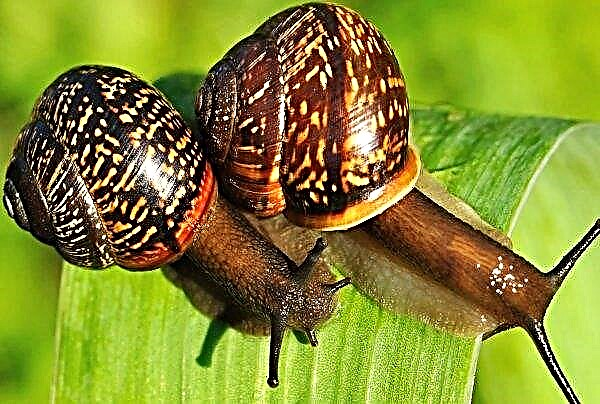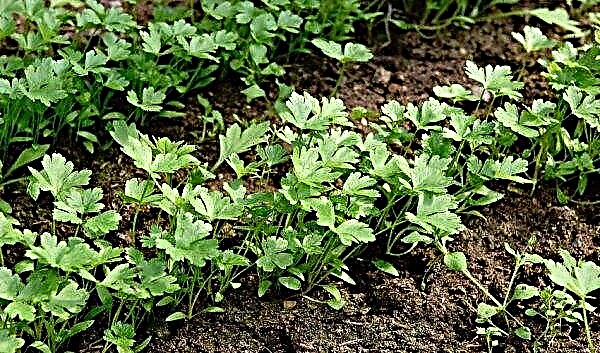Growing tomatoes in a greenhouse makes it possible to get the crop ahead of schedule, and in heated rooms all year round. But for this it is necessary to make a lot of effort. Indoors, plants often suffer from a lack of fresh air and fertilizers, which negatively affects crop yields. Consider the main nuances regarding root and foliar top dressing.
Features of growing tomatoes in a greenhouse
Starting the process of growing tomatoes in a greenhouse, you need to choose the right variety. For unheated rooms from polycarbonate, early and mid-early varieties are suitable, in heated plants you can grow any plants. It is better to give preference to indeterminate varieties - they differ in unlimited growth and a long fruiting period. This will allow you to harvest a rich crop from a relatively small area.
Did you know? The first greenhouses appeared in ancient Rome. The process of growing fruit and ornamental plants was carried out in carts filled with soil. In the afternoon they were rolled out in the sun, and at night they were brought into specially equipped rooms. In cold weather, the wagons were kept indoors all the time, which made it possible to get the crop all year round.
The next step is proper soil care. The best option after harvesting is to remove a layer of soil 15–20 cm thick and replace it with a new one. Constant disinfection depletes the soil and contributes to the accumulation of toxins in it.
The greenhouse should be equipped with an elementary ventilation system, lighting, have access to water. For full pollination, ventilation alone will not be enough, even if the greenhouse opens from above. Flowering bushes should be shaken periodically so that pollen moves from the upper flowers to the lower ones.
Video: The subtleties and secrets of caring for tomatoes in a greenhouse
Why tomatoes need fertilizers
Fertilizing at certain stages of plant life allows you to:
- help cultures form a complete root system and ground;
- increase productivity;
- protect plantings from the negative effects of the environment and pests;
- quickly restore the strength of the plant with mechanical damage;
- help to adapt to a new place after a dive.

When and how often to feed tomatoes in a greenhouse
Fertilizer application for closed ground:
- 2 weeks after transplantation under shelter;
- 14 days after the first feeding;
- in the flowering phase;
- in the fruiting phase.
Types of fertilizers of greenhouse tomatoes
There are 2 types of top dressing:
- root
- foliar.
Video: Root and foliar top dressing of tomatoes during flowering
For full development, plants need 3 main minerals:
- nitrogen;
- potassium;
- phosphorus.
The greenhouse microclimate promotes the growth of bacteria and pests, so the application of fertilizers under the root is combined with foliar treatment with Fitoverm. The tool belongs to the group of biological products. Unlike pesticides, it can be used at any phase of plant development, including pouring and the technical maturity of the fruit.
Important! Fitoverm is not compatible with chemicals.
The drug acts with a vengeance if you spray them with plants in the heat. The main active substance is aversectin. It is obtained by processing mycoplasmas of fungal spores living in the soil. It is used for preventive purposes and for treating plants from fungal diseases, as well as attacks of pests that breed in a moist, warm environment. In addition to the main action, it helps to improve the absorption by the roots of nutrients from the soil and nourishes the leaf part. It is not used as the main fertilizer for tomatoes, as it cannot provide plants with all the necessary minerals for full development.
Organic
Organics can be introduced right up to the fruit pouring phase.
The main types of organic top dressing:
- wood ash - is applied in pure form or dissolved in water;
- horse and cow manure - applied as root dressing, dissolved in water in a ratio of 1: 1;
- compost - applied to the soil at the time of planting and used as mulch;
- bone meal - 300 g / sq. m;
- peat and river sludge - 10 kg / sq. m before planting or at the time of soil preparation in the fall.

Mineral
Mineral fertilizers can be:
- one-component;
- complex.
One-component ones include:
- Urea - includes nitrogen compounds, is applied in powder form directly to the soil with subsequent aeration or in the form of an aqueous solution (1 tbsp. L / 10 l of water).
- Superphosphate - includes phosphates, is poorly soluble in water, and in its dry form is hardly absorbed by the roots. The solution is prepared at the rate of 1 tbsp. l substances per 1 liter of boiling water and insist for a day, and then the concentrate is diluted in 10 liters of water. In dry form, it is applied to the soil at the time of its preliminary treatment 6–8 months before planting.
- Potassium sulfate - fertilizer is bred in water. 10 g leaves 40 g of substance. This is enough to fertilize 1 square. m of soil.
- Potassium monophosphate - consists of 70% phosphorus and 30% potassium. 10 g of water will require 15 g of substance. It is introduced in the flowering phase.

Complex mineral supplements:
- Diammofoska - includes phosphorus, potassium and nitrogen. It is used at the stage of soil preparation as the main nutrient at the rate of 40 g / sq. m. For root top dressing is used in the form of an aqueous solution (2 tsp / 10 l of water).
- Ammofoska - consists of phosphorus (80%) and nitrogen (20%). It is applied in a dry form at a distance of 10 cm from the main stem of 20-30 g / sq. m
- Nitroammofoska - contains 3 basic minerals in equal proportions. It is applied in the form of root top dressing at the rate of 40 g / 10 l of water.
Did you know? Nitrogen is a mineral compound, without which no living organism can function. Get it literally from the air. In special apparatuses, ammonia with oxygen, reacting with a platinum catalyst, is converted into nitric oxide in seconds. After secondary enrichment with oxygen, nitrogen dioxide is formed, which is used in the manufacture of the most valuable fertilizer on Earth - ammonium nitrate.
Folk remedies
If you want to do without chemistry when growing tomatoes, then folk remedies will be a worthy replacement.
The most effective folk remedies:
- Yeast infusion - 25 g of dry yeast is mixed with 2 tbsp. sugar and 200 ml of warm water and leave for 30 minutes. Then mixed with 10 l of water and contribute 0.5 l to each plant. Top dressing is effective at the stage of ovary formation.
- Nettle infusion - 8 kg of fresh nettle leaves are poured with 10 liters of water. Insist 7-10 days at a temperature of +25 ° C. The fermented concentrate is diluted with water 1:10. Each plant takes 1-2 liters. Top dressing is carried out no more than 3 times a season.
- Banana skins - 2-3 peels pour 3 liters of water and insist 3-5 days. The resulting solution is diluted in 10 l of water and the plants are watered under the root. The infusion is effective at the time of flowering.
- Eggshell - in the form of powder is applied at the time of soil preparation in the fall. After diving seedlings in the ground, use an infusion. 2-3 egg shells, previously crushed, are placed in a glass container and pour 3 liters of water. Insist until an unpleasant odor occurs. Then the concentrate is diluted in 10 l of water.

How to fertilize properly
Uncontrolled application of nutrients to the soil can destroy plants, so it is important to consider the needs of plants in a certain growth phase. Fertilizers are applied in the morning or in the evening, combining them with watering. For example, watering is carried out in the morning, and fertilizers are applied in the evening, or vice versa. After the liquid is absorbed, loosening is carried out to a depth of 5 cm near the stem, 10 cm - in the aisles.
Immediately after landing
After landing in a new place, it is necessary to feed the tomatoes with nitrogenous substances in order to ensure the development of the ground part and accelerate the adaptation process in the new place. After planting under cover, the soil is poured with a solution of ash at the rate of 800–1000 ml per well. After that, the soil is mulched with peat or compost.
After 2 weeks, plants are fed with liquid mullein, making 200 ml under each bush.
Important! If the plant looks sluggish, and the growth of the terrestrial part has slowed down - it suffers from a lack of nitrogen. The introduction of dry urea, 20-30 g per well, will quickly correct the situation. The soil after applying the powder substance must be loosened. Urea, reacting with air, is converted into a volatile compound, so if you do not deepen it into the soil, top dressing will be ineffective.
During flowering
At the time of flowering, plants need phosphorus and potassium. At this point, potassium monophosphate is suitable. 10 l of the finished solution is enough to enrich the minerals 1 square. m of plantings. During this period, it is necessary to properly ventilate the room and periodically shake the plants to ensure full pollination of flowers.

During fruiting
During fruit setting, you can use organics in the form of manure dissolved in water or compost infusion. For each plant accounts for 300-400 ml of solution.
In the fruit pouring phase, yeast infusion with the addition of bone meal is used. 300 g of flour is added to 10 liters of the finished infusion. Consumption - 2 liters per plant.
Video: Fertilizing tomatoes during fruiting
Watering tomatoes
On average, watering is carried out every 5 days. Soil moisture is maintained within 70–80%, air humidity - 50-60%. One adult plant takes 5 liters of fluid. When applying root dressings in the form of solutions during irrigation, the amount of water is reduced. For example, when 2 liters of solution are added in the morning, 3 liters of water is poured into the hole in the evening.
The best option is to organize a drip irrigation system in the greenhouse. In this case, the grower has the opportunity to control the flow of water to the wells. An irrigation system is located in the central part of the garden, from which pipes are drawn to each plant, equipped with nipples.A correctly selected feeding scheme for tomatoes in greenhouse conditions can increase productivity by 15%, as well as activate the protective abilities of the plant body. Without fertilizers, tomatoes are not able to fully develop and bear fruit.


